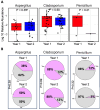Dysbiosis in the Nasal Mycobiome of Infants Born in the Aftermath of Hurricane Maria
- PMID: 40871288
- PMCID: PMC12388473
- DOI: 10.3390/microorganisms13081784
Dysbiosis in the Nasal Mycobiome of Infants Born in the Aftermath of Hurricane Maria
Abstract
Hurricanes and flooding events substantially elevate indoor fungal spore levels, which have been associated with increased risks of developing childhood asthma and other adverse respiratory outcomes. Although environmental fungal compositions following major hurricanes have been well characterized, the fungal communities within the nasal cavity (i.e., the nasal mycobiome) of exposed individuals remain unexplored. We collected nasal swab samples from infants following Hurricane Maria in San Juan, Puerto Rico, during two periods (March to August 2018 and February to September 2019). We processed a total of 58 samples (26 from the first year and 32 from the second year post-Hurricane Maria) and performed internally transcribed spacer (ITS) rRNA gene sequencing to characterize and compare the infant nasal mycobiome between the two groups. Although alpha-diversity did not differ significantly, beta-diversity analyses revealed significantly different fungal compositions between the two groups (p <0.01). Infants exposed during the first year post-Hurricane Maria had significantly higher abundances of Alternaria, Eutypella, Schizophyllum, and Auricularia, compared to infants from the second year. Alternaria was also more prevalent in the first-year than in the second-year infants (42% vs. 9%, p = 0.01). Our study provides evidence linking early-life hurricane exposures to elevated risks of developing childhood asthma.
Keywords: HOLA cohort study; Hurricane Maria; climate change; fungi; infant nasal mycobiome.
Conflict of interest statement
The authors declare no conflict of interest.
Figures




Similar articles
-
Prescription of Controlled Substances: Benefits and Risks.2025 Jul 6. In: StatPearls [Internet]. Treasure Island (FL): StatPearls Publishing; 2025 Jan–. 2025 Jul 6. In: StatPearls [Internet]. Treasure Island (FL): StatPearls Publishing; 2025 Jan–. PMID: 30726003 Free Books & Documents.
-
Neighborhood Disadvantage and the Association of Hurricanes Sandy and Harvey With Veterans' Mental Health.JAMA Netw Open. 2025 Jan 2;8(1):e2455013. doi: 10.1001/jamanetworkopen.2024.55013. JAMA Netw Open. 2025. PMID: 39821395 Free PMC article.
-
The effect of sample site and collection procedure on identification of SARS-CoV-2 infection.Cochrane Database Syst Rev. 2024 Dec 16;12(12):CD014780. doi: 10.1002/14651858.CD014780. Cochrane Database Syst Rev. 2024. PMID: 39679851 Free PMC article.
-
Puerto Rico exodus: Long-Term Economic Headwinds Prove Stronger than Hurricane Maria.Popul Environ. 2020 Sep;42(1):43-56. doi: 10.1007/s11111-020-00355-5. Epub 2020 Jul 28. Popul Environ. 2020. PMID: 40792202 Free PMC article.
-
Systemic pharmacological treatments for chronic plaque psoriasis: a network meta-analysis.Cochrane Database Syst Rev. 2021 Apr 19;4(4):CD011535. doi: 10.1002/14651858.CD011535.pub4. Cochrane Database Syst Rev. 2021. Update in: Cochrane Database Syst Rev. 2022 May 23;5:CD011535. doi: 10.1002/14651858.CD011535.pub5. PMID: 33871055 Free PMC article. Updated.
References
-
- Poole J.A., Barnes C.S., Demain J.G., Bernstein J.A., Padukudru M.A., Sheehan W.J., Fogelbach G.G., Wedner J., Codina R., Levetin E., et al. Impact of weather and climate change with indoor and outdoor air quality in asthma: A Work Group Report of the AAAAI Environmental Exposure and Respiratory Health Committee. J. Allergy Clin. Immunol. 2019;143:1702–1710. doi: 10.1016/j.jaci.2019.02.018. - DOI - PMC - PubMed
-
- D’Amato G., Chong-Neto H.J., Monge Ortega O.P., Vitale C., Ansotegui I., Rosario N., Haahtela T., Galan C., Pawankar R., Murrieta-Aguttes M., et al. The effects of climate change on respiratory allergy and asthma induced by pollen and mold allergens. Allergy. 2020;75:2219–2228. doi: 10.1111/all.14476. - DOI - PubMed
-
- Vélez-Torres L.N., Bolaños-Rosero B., Godoy-Vitorino F., Rivera-Mariani F.E., Maestre J.P., Kinney K., Cavallin H. Hurricane María drives increased indoor proliferation of filamentous fungi in San Juan, Puerto Rico: A two-year culture-based approach. PeerJ. 2022;10:e12730. doi: 10.7717/peerj.12730. - DOI - PMC - PubMed
Grants and funding
LinkOut - more resources
Full Text Sources

